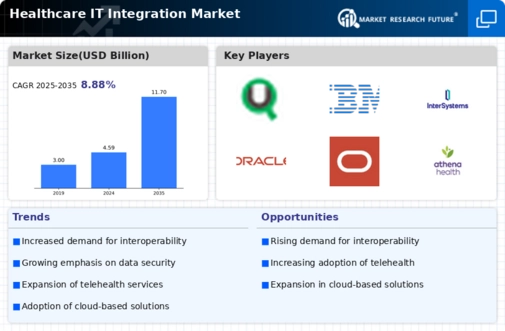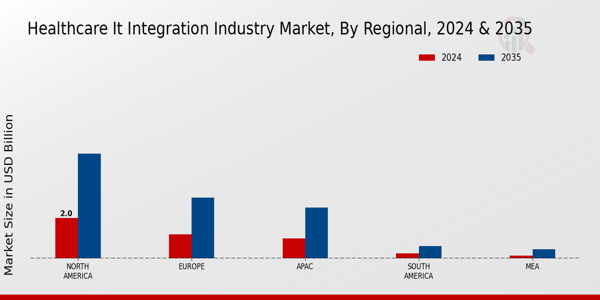Market Growth Projections
The Global Healthcare IT Integration Market Industry is poised for substantial growth, with projections indicating a market value of 4.59 USD Billion in 2024 and an anticipated increase to 11.7 USD Billion by 2035. This growth trajectory suggests a robust demand for integrated healthcare IT solutions, driven by factors such as interoperability, regulatory compliance, and technological advancements. The expected compound annual growth rate (CAGR) of 8.88% from 2025 to 2035 further underscores the market's potential. These figures reflect a broader trend towards the integration of healthcare IT systems, which is essential for improving patient care and operational efficiency.
Regulatory Compliance and Standards
Regulatory compliance plays a crucial role in shaping the Global Healthcare IT Integration Market Industry. Governments worldwide are implementing stringent regulations to ensure data security and patient privacy. For instance, the Health Insurance Portability and Accountability Act (HIPAA) in the United States mandates specific standards for electronic health information. Compliance with such regulations necessitates the integration of advanced IT systems that can manage and protect sensitive data. As healthcare organizations strive to meet these requirements, the demand for integrated solutions is expected to rise, thereby propelling market growth. This focus on compliance is likely to foster a more secure healthcare environment.
Growing Focus on Patient-Centric Care
The Global Healthcare IT Integration Market Industry is increasingly oriented towards patient-centric care, emphasizing the importance of personalized treatment plans and improved patient engagement. Healthcare providers are recognizing that integrated IT solutions can enhance the patient experience by providing comprehensive access to health information. This focus on patient-centricity is driving the adoption of integrated systems that facilitate communication between patients and providers. As organizations strive to deliver tailored care, the demand for healthcare IT integration is likely to rise, contributing to market growth. This shift towards patient-centric models signifies a fundamental change in healthcare delivery.
Increasing Demand for Interoperability
The Global Healthcare IT Integration Market Industry experiences a growing demand for interoperability among healthcare systems. As healthcare providers increasingly seek to share patient data seamlessly, the need for integrated IT solutions becomes paramount. This trend is evidenced by the projected market value of 4.59 USD Billion in 2024, indicating a robust investment in technologies that facilitate data exchange. Interoperability not only enhances patient care but also streamlines operations, thereby reducing costs. The emphasis on integrated systems is likely to drive innovation and adoption of advanced healthcare IT solutions, ultimately contributing to improved healthcare outcomes.
Rising Adoption of Telehealth Services
The Global Healthcare IT Integration Market Industry is witnessing a surge in telehealth services, driven by the increasing need for remote patient monitoring and virtual consultations. This trend is particularly relevant as healthcare providers seek to enhance accessibility and convenience for patients. The integration of telehealth platforms with existing healthcare IT systems enables seamless communication and data sharing, which is essential for effective patient management. As telehealth continues to gain traction, the market is projected to grow significantly, with estimates suggesting a value of 11.7 USD Billion by 2035. This shift towards telehealth indicates a broader transformation in healthcare delivery models.
Technological Advancements in Healthcare IT
Technological advancements are a key driver of the Global Healthcare IT Integration Market Industry. Innovations such as artificial intelligence, machine learning, and cloud computing are revolutionizing the way healthcare data is managed and integrated. These technologies facilitate real-time data access and analytics, enabling healthcare providers to make informed decisions. As organizations increasingly adopt these advanced solutions, the market is expected to experience a compound annual growth rate (CAGR) of 8.88% from 2025 to 2035. The integration of cutting-edge technologies not only enhances operational efficiency but also improves patient outcomes, thereby reinforcing the importance of IT integration in healthcare.























